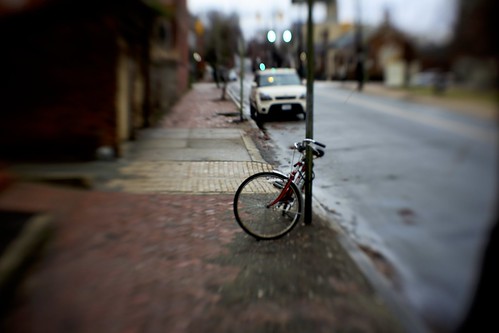I figured I’d blend this week’s walking at work photos with a larger reflection as they mesh together pretty well. Partially because my reflections are blurry and distorted. The photos actually hurt my head a bit and so does trying to knit all this interesting stuff together. The following is a reflection on the course design process thus far and my own attempts to document the course design process. Messy.

cc licensed ( BY SA ) flickr photo shared by Tom Woodward
I’m going to try to capture some of the conversations that have been going on the past few days between Jon Becker, Gardner Campbell, and myself as we start to pull this summer’s MOOC together. I’m doing this in part to further refine my own thoughts but also to play around with Englebart’s idea of a dynamic knowledge repository (one possible element of the course). This will, of course, represent my own slightly askew view of the proceedings but I trust neither Jon nor Gardner would be shy about throwing their opinions in the mix.

cc licensed ( BY SA ) flickr photo shared by Tom Woodward
The conversations have been wide ranging in many interesting and occasionally confounding ways. With an initial goal not to overly define the destination- not to create the rubric-based “prophylactic effect” (That’s Jon quoting Gary Stager and it has come up repeatedly.) and three people who tend to find and enjoy odd connections between lots of things.1 I’m enjoying myself immensely but I can also see how it’d drive some people I’ve worked with insane as the semi-specifics of the target and the path tend to drift and shift in so many ways during the conversation.
It is coincidental but not unimportant that I have been shooting all this week with a tilt-shift lens. My head feels kind of like that- slightly distorted, a few variables more than I’m used to . . . There remains the possibility of using lenses and focus as a metaphor to help guide the course. The idea of finding, framing, and focusing research and the fact that those processes blurred and impacted one another in an ongoing and fluid way was discussed at length. Tilt-shift lenses were discussed as was racking focus in film. We are going to make a course trailer for the course and it’s likely both will find a home in the final product.

cc licensed ( BY SA ) flickr photo shared by Tom Woodward
It is hard to capture these discussions. Part of what I’ve been trying to think through is how to document those conversations and capture the important pieces in a way that is functional. My own definition of “functional” is mainly focused on the process being useful in the moment as well as the future and where the energy and time put in for the documentation does not end up feeling punitive and allows you to continue in the flow of the face to face conversation. I didn’t start out with that explicit goal. I was originally taking notes mainly for myself and it was/is hard to do that.2 Additional audiences and purposes began to creep up as these meetings progressed. The idea of using this process as an example for course creation, sharing it with other members of different VCU groups etc. That changed things considerably for me.
It’s a bit like shooting in RAW vs JPG or having something like the Lytro. If I’m documenting for multiple audiences and purposes I need to capture much more data and frame it in fairly different ways. That additional data comes at a cost- a capture/creation cost, a storage cost, and a post-processing cost. It all needs to be considered. You can always compress things for specific audiences/purposes but recapturing data you opted not to capture is often impossible. You can’t take a JPG and make a RAW file. Data lost is data lost. At the same time, I could shoot a video or record the audio (negating the need to be “out of the moment” and ensuring all the data will be there) but I know that weight is probably too great on the post-processing end.3

cc licensed ( BY SA ) flickr photo shared by Tom Woodward
This may become my tag line "Living the Dream: Networked Lenses, Quantified Selfies, and Digital Wandering"
— Tom Woodward (@twoodwar) January 9, 2014
I don’t know that “Living the Dream: Networked Lenses, Quantified Selfies, and Digital Wandering” will have anything to do with the theme of the course in the end but it gets at lots of odd things in a way I like. “Living the Dream” is an attempt to pull in the idea that Doug Englebart and many others had these amazing visions that we have met/not met in various ways. I hope students will look at these ideas from a past fairly well removed from themselves and wonder if they are realizing these grand aspirations. Networked lenses plays off the idea of the changes brought about by cameras with wifi and the idea of instant publishing which is overly sold here but also reflective of networks as lenses of focus and filtration. Quantified selfies is something Jon coined when we were discussing the two topics. I love it as a phrase as it leads to all sorts of questions. Both selfies and quantified self are seemingly focused on the “I” yet they’re viewed very differently. I want to pull in all sorts of things about selfies. It’d also be interesting to use quantified self as a reflective lens to help determine degrees of Englebartian techno-dream fulfillment. The wandering part goes back to the idea that curiosity and passion ought to be guiding our steps in this course. Making odd connections and evolving your questions and thoughts in non-standard ways is desired.

cc licensed ( BY SA ) flickr photo shared by Tom Woodward
Creating real choice in a course is always interesting. In large part, I think, because it feels like a trap and it is against what you’ve been taught to do throughout school. Choice in schools is usually cafeteria tray choice. Feel free to choose from our limited and unappetizing entrees!4 This will be a change and a significant one. Making this change happen quickly will require some real thought and effort.
We’ve talked about lots of things students might create to show their progress and additionally we’ve looked at places where free-range humans spend time teaching/learning/arguing/communicating. Reddit has interesting depths for the uninitiated. Gardner noted a reddit called “Change My View– For people who have an opinion on something but accept that they may be wrong or want help changing their view.” Explain It Like I’m Five is another reddit where people ask and answer questions- while attempting to keep it simple. There are other meme like explanation attempts floating around the Internet like this XKCD example which uses just the 100 most common English words. XKCD’s “What If?” is also an unbelievably wonderful example of how interesting questions lead to interesting research and a changing destination.5 There’s even a Twitter account for interesting numbers that come up while research the initial question.
Gardner brought us to this Feyman video. Watching Feynman explain magnetism does remind me of the XKCD shifting answer jujitsu. How do we get students wandering down similar paths.6

cc licensed ( BY SA ) flickr photo shared by Tom Woodward
Jon got us down the S track and even went as far as to purchase the book. It is essentially two novels in one with ARG like elements.
A parallel course in the margins of the course sounds like a lot of fun to me and the Internet seems like a perfect fit. Making this other course challenge the course itself with alternative narrators, deliberate attempts to expand etc. would be even more fun. There are elements of unreliable narration, puzzles/ARG elements etc. that could play out here in ways that would be much more difficult in the main course.
Excerpt7 from Two Tramps in Mud Time
Nothing on either side was said.
They knew they had but to stay their stay
And all their logic would fill my head:
As that I had no right to play
With what was another man’s work for gain.
My right might be love but theirs was need.
And where the two exist in twain
Theirs was the better right–agreed.But yield who will to their separation,
My object in living is to unite
My avocation and my vocation
As my two eyes make one in sight.
Only where love and need are one,
And the work is play for mortal stakes,
Is the deed ever really done
For Heaven and the future’s sakes.–Robert Frost
Gardner brought this poem up. I’d never read it before. It speaks pretty specifically to my hopes- the unification of avocation and vocation. Do what you love. It’s the lateral thinking that might be required to determine what it is you love and how you might do it that is intriguing to me. School ought to encourage this bending and blending but usually does the opposite. Our goal is to do better, to send the tramps on their way and never yield the axe.8
1 I have not had a conversation yet where I knew all the references, videos, authors, websites, concepts. As noted in our conversation, the death of the cyberflaneur is exaggerated.
2 Jotting down notes/ideas/resources can feel like you aren’t in the moment. It’s the opposite of how I felt taking notes in most classes. There I played my role as secretary and simply wrote what the instructor said. I’d set challenges- like writing backwards, or left-handed, or upside down, or some combination of all of those.
3 Maybe I need an intern.
4 Traveling Nachos are available every Tuesday and yes that’s real and Henrico County it.
5 My favorite remains “What would happen if everyone on Earth jumped at the same time?” The way this question is woven into a much more interesting answer is beautiful and representative of the kind of thinking that I hope would be useful and interesting to students.
6 Super aside — I also find myself wondering about demagnetizing things and how we might do something similar with the electric repulsion of everyday objects. I also wonder if we could boost the repulsion force so we’d bounce.
7 It’s well worth reading the whole thing. He does some really nice tricks with language. I really liked the bluebird line.
8 A bit hyperbolic perhaps but I encourage you to try to take an axe from me.
